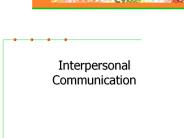Effective Communication - PowerPoint PPT Presentation
1 / 21
Title:
Effective Communication
Description:
Kinesics, Proxemics & Paralanguage. Persuasive Communication ... Proxemics ( Personal Space Language) Paralanguage ( Non Verbal Aspects Pitch, Tone ... – PowerPoint PPT presentation
Number of Views:160
Avg rating:3.0/5.0
Title: Effective Communication
1
Effective Communication
- Vivek Kumar Singh
- Department of Computer Science
- Banaras Hindu University, Varanasi-221005
- Email vivek_at_bhu.ac.in
2
Agenda
- The Communication process
- Importance of Communication
- Barriers in Communication
- Types of Communication
- Kinesics, Proxemics Paralanguage
- Persuasive Communication
- Steps to make communication effective
3
Communication
- Transfer of information and knowledge from source
to receiver. - Its the process by which the sender/ source
reaches the receiver/ destination with thoughts,
ideas, feelings, facts values. - Successful communication is said to be
accomplished when the receiver not only receives
the message but also accept, interpret and use it
in the manner intended by the source.
Communication is receiver centered.
4
(No Transcript)
5
The Communication Process
- Involves two or more parties
- One or more is the sender with intentions to
convey - The intentions of the sender are expressed in a
message - The message is communicated by the sender in
terms of signals along some medium - One or more of the other parties is a receiver.
Receivers have the ability to interpret the
signals.
6
Examples of communication
- Face-to-face conversation
- Telephone conversation
- A gesture
- A letter
- A sign
- A ringing alarm clock
7
The Communication Process (again..)
Sender
Receiver
Transmission through a channel
Reception of the message by receiver
Decoding
Source
Encoding
Use of Message
Feedback
8
Elements in Communication
- Source
- Encoding (Language Non Verbal cues)
- Message
- Channel (Formal or informal)
- Reception
- Decoding (Receivers perception
Interpretation) - Use
- Feedback (suggestions for sender, Completes the
- process)
9
Aspects of communication
- Involves human intentions and interpretation
- Requires a wholly or partially shared context and
set of conventions (a sign-system) - Effective communication happens when there is a
high correspondence between the senders
intentions and the receivers interpretation of
the message
10
Importance of Communication
- Increases adaptability in environment
- Both Organization Individuals cannot exist
without communication - Managerial functions depend on Communication
- Essential for motivation and Attitude development
Good Communication is the foundation of sound
management Peter Drucker
11
Barriers in Communication
- Semantics
- (Abstract Words, Concrete Words, Foreign
- Words, mismatch in body lang message)
- Psychological or Interpersonal barriers
- (Attitudes Values, Experiences, Halo effect,
Psychological distance, Dependency Syndrome,
Filtering) - Physical Barriers
12
Types of Communication
- Verbal
- Written
- Oral
- Non Verbal
- Sign Language
- Action Language
- Object Language
Perceived Attitude 55 Facial Exp. 38
Paralang. 7 Verbal
13
Kinesics, Proxemics Paralanguage
- Kinesics
- ( Touch, Gestures, Head nods, Eye Contact,
- Postures, Facial Expression)
- Proxemics
- ( Personal Space Language)
- Paralanguage
- ( Non Verbal Aspects Pitch, Tone
- Pause, Accent, Speech Errors)
14
Persuasive Communication
- Involves 3 elements
- (Persuader, Persuadee, Persuasive Appeal)
- Difference in Persuasive Effective
Communication - Source Characteristics
- ( Credibility, Power, Attractiveness of the
- Source)
15
Persuasive Communication (Contd.)
- Message Characteristics
- ( Suggestion, Fear Appeal, Drawing
- Conclusions, Sidedness of message,
- Ordering of message, Factual vs Emotional
- Appeals, Pleasant forms of distraction,
- Active Participation)
- Receiver Characteristics
- ( Selective Exposure, Selective Attention,
- Selective Interpretation)
16
Persuasive Communication (Contd..)
- Personality Characteristics
- ( Sex, Self Esteem, Intelligence)
17
Making Communication Effective(1)
- Short Simple Sentences Unambiguous words
- Face to Face Communication, wherever possible
- Supplement with examples Illustrations
- Use Feedback
- Plan the Communication
18
Making Communication Effective (2)
- Develop empathy with audience
- Make Verbal message congruent with Non Verbal
message - Align message contents from receivers view point
- Understand Physical human environment
- Organizational Structure to minimize filtering
19
Making Communication Effective (3)
- Create environment for free expression of ideas
- Use Credible source
- Listen carefully
- Preparing ground by communicating something of
interest or value to audience
20
Delivering the right information
- More data ? better information
- Information needs to be timely
- Information needs to be accurate
- There is a trade-off between timeliness, accuracy
and cost - Garbage in garbage out
- Output has to be tailored to the situation in
which it will be used
21
- Thank you !































